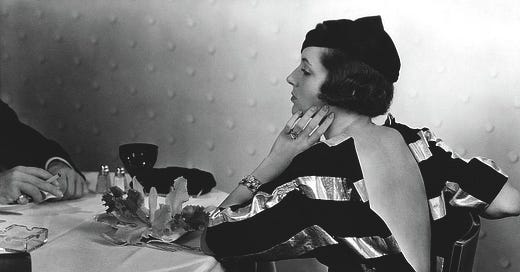If you were to plan an ideal day of dressing, what would you wear? How many times would you change? Where would you go to show off these dream looks?
Take a little inspiration from a more elegant time with this editorial taken by the great Edward Steichen. At the time of this shoot, Steichen was chief photographer for Condé Nast’s magazines Vogue and Vanity Fair—a role he held from 1923 to 1938—and was widely considered the most popular and highest-paid photographer in the world. Steichen had been the first photographer to bring a painterly, pictorialist aesthetic to fashion photography in a landmark spread of images published in the April 1911 issue of Art et Decoration; while previously published fashion photographs had been straightforward fashion plates, Steichen drew from his own pictorialist background and from fashion illustrations to capture Paul Poiret’s designs in highly evocative, atmospheric images where there is the sense that the models are inhabiting their lives in these clothes. Though he would not take another fashion image for over ten years (until Nast invited him to replace Baron Adolph de Meyer, the other father of fashion photography), Steichen’s influence was pronounced on the development of the craft.
While Steichen’s images had taken on a more focused and formal tone in the intervening years, the photographs in the editorial below still capture the garments within the setting of a woman’s life. For this photo story, Steichen chose Mrs. William Wetmore to portray the archetypal fashionable New York society woman. Joan Deery was born in Sydney, Australia, on August 29, 1911, and moved with her family to New York in 1917. In late March 1930, at just 19 years old, she eloped with William Wetmore, a Harvard hockey and football star. As the son of architect Charles Deleven Wetmore, of the well-known New York firm Warren & Wetmore (responsible for Grand Central Terminal, among many other legendary buildings), Bill introduced his young bride into society—her beauty and grace captivating all. She became one of Steichen’s preferred models, her elegant face and dark locks appearing often on the pages of Vogue.

During this period, Joan also began to study acting under Benno Schneider, “a drama teacher who had once been a member of Stanislavski’s Art Theatre in Moscow, and now ran his own school in New York. (In time he was the Columbia Studio drama coach, and his many pupils included Kim Novak, Gene Tierney, Vincent Price and James Garner).” By the late 1930s, her marriage had fallen apart and she was starting to appear onstage, as Joan Wetmore. While her name is forgotten today, Joan appeared on stage (Broadway, off-Broadway, and across the country) until the 1970s with numerous TV roles between 1949 and 1965—by all appearances, a very long and successful career.1 She passed away from cancer in 1989.
All images and text below from Vogue, October 15, 1933; all photos by Edward Steichen.
Keep reading with a 7-day free trial
Subscribe to Sighs & Whispers to keep reading this post and get 7 days of free access to the full post archives.





